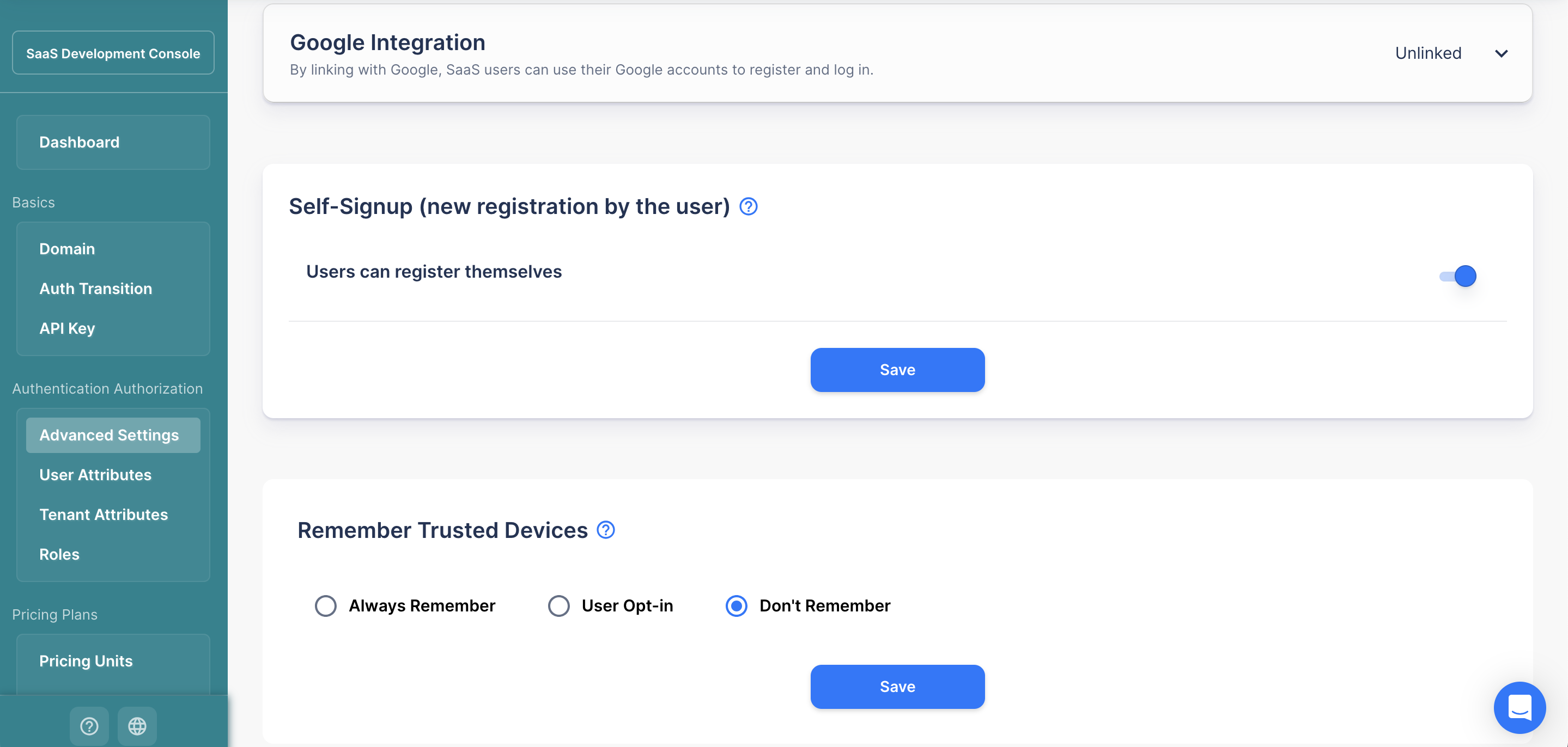About SaaS User Accounts
This document will explain how SaaS user accounts are managed on the SaaSus Platform.
1. Components of an Account
An account consist of the following elements, which must all be set to allow usage:
- SaaS User
Stores the authentication data (ID, Password) for the SaaS - Tenant User
Stores which tenant the SaaS user belongs to - Role
Stores which permissions the tenant user has
2. About Relations
A SaaS user can belong to multiple tenants.
Also, a user can have multiple roles within a tenant.
Example)
User A belongs to tenant A and has the role of Administrator.
User A also belongs to tenant B and has roles of both Administrator and Regular User.
It can be expressed diagrammatically as follows:
3. About Account Creation Patterns
- Case of Self-Signup
Example)
The user who wants to use the SaaS creates their own account from a self-signup page.
The tenant is created at the time of account creation, and the user becomes the administrator of that tenant. - Case where the SaaS has a User Creation Function Implemented
Example)
The tenant's administrator creates roles of "Administrator" and "Regular User" using the user creation function. - Case where an Account is Created from the SaaS Operation Console
Example)
Upon request from a user, the SaaS administrator creates an account from the SaaS Operation Console.
sign in information is notified to the user via email or EventBridge integration, and the user starts using the account.
3.1. Implementation for Self-Signup Case
3.1.1. Allow User Self-Signup
SaaS Development Console - Authentication Authorization - Advanced Settings - Authentication Tab - Self-Signup (new registration by the user)
Enable "Users can register themselves".

When allowing self-signup, "Sign up here" will be displayed on the sign in page generated by the SaaSus Platform.

The users can create accounts from this link.
What gets created here is the 'SaaS User' in the components of an account.
3.1.2. Implement Handling of Post-Self-Signup Process
When self-signup is completed, the user transitions to your SaaS in a sign in state.
The transition page can be set at:
SaaS Development Console - Basics - Auth Transition - Callback URL
When self-signup is enabled, the following judgement needs to be made at the Callback URL.
This verification can be performed by checking whether the tenants information is included within the UserInfo array obtained from the SaaSus Platform.
- PHP
- Node.js
- Go
- Python
- Java
- C#(.Net8)
- C#(.Netfw4.8)
// Implement self-signup process if tenant registration isn't done
if (empty($request->userinfo['tenants']))
const userInfo = request.userInfo
// Implement self-signup process if tenant registration isn't done
if (!userInfo.tenants || userInfo.tenants.length === 0)
userInfo, ok := c.Get(string(ctxlib.UserInfoKey)).(*authapi.UserInfo)
// Implement self-signup process if tenant registration isn't done
if len(userInfo.Tenants) == 0
// Implement self-signup process if tenant registration isn't done
if not auth_user.tenants:
// Implement self-signup process if tenant registration isn't done
if (userInfo.getTenants() == null || userInfo.getTenants().isEmpty())
// Implement self-signup process if tenant registration isn't done
if (userInfo.Tenants == null || !userInfo.Tenants.Any())
// Implement self-signup process if tenant registration isn't done
if (userInfo.Tenants == null || !userInfo.Tenants.Any())
3.1.3. Implementation Sample
Try modifying the Creating a Tenant, so that tenant registration can be done.
Once tenant registration can be done, let's assign a user to a tenant and set a role.
After creating a tenant and a tenant user, verify whether the configured tenant information appears in the tenants array within UserInfo.
- PHP
- Node.js
- Go
- Python
- Java
- C#(.Net8)
- C#(.Netfw4.8)
dd($request->userinfo['tenants']);
const userInfo = request.userInfo
console.log(userInfo.tenants)
fmt.Printf("Tenants: %+v\n", tenants)
print(auth_user.tenants)
UserInfo userInfo = null;
userInfo = userInfoApi.getUserInfo(getIDToken(request));
System.out.println(userInfo);
var authApiClientConfig = CreateClientConfiguration(c => c.GetAuthApiClientConfig(), context);
var userInfoApi = new UserInfoApi(authApiClientConfig);
var userInfo = await userInfoApi.GetUserInfoAsync(token);
Console.WriteLine(string.Join("\n", userInfo.Tenants.Select(tenant => tenant.ToString())));
var authApiClientConfig = CreateClientConfiguration(c => c.GetAuthApiClientConfig());
var userInfoApi = new UserInfoApi(authApiClientConfig);
var userInfo = await userInfoApi.GetUserInfoAsync(token);
foreach (var tenant in userInfo.Tenants)
{
Console.WriteLine(tenant.ToString());
}
Once the tenant information can be obtained, and the tenant user has been created, try to sign in through a normal sign in flow to verify if it works.
3.2. Implementation for the Case where SaaS have User Creation Feature
Let's implement the case where the administrator, who self-signed up, creates a new user.
Firstly, register a new user on SaaS.
- PHP
- Node.js
- Go
- Python
- Java
- C#(.Net8)
- C#(.Netfw4.8)
$client = new ApiClient();
$authApiClient = $client->getAuthClient();
$createSaasUserParam = new CreateSaasUserParam();
$createSaasUserParam
->setEmail($inputs['email'])
->setPassword($inputs['password']);
$authApiClient->createSaasUser($createSaasUserParam);
const client = new AuthClient()
const createSaasUserParam: CreateSaasUserParam = {
email,
password
}
await client.saasUserApi.createSaasUser(createSaasUserParam)
var authClient *authapi.ClientWithResponses
createSaasUserParam := authapi.CreateSaasUserJSONRequestBody{
Email: email,
Password: password,
}
_, err = authClient.CreateSaasUser(context.Background(), createSaasUserParam)
from saasus_sdk_python.src.auth import SaasUserApi, CreateSaasUserParam
api_client = SignedAuthApiClient()
create_saas_user_param = CreateSaasUserParam(email=email, password=password)
SaasUserApi(api_client=api_client).create_saas_user(create_saas_user_param=create_saas_user_param)
AuthApiClient apiClient = new Configuration().getAuthApiClient();
apiClient.setReferer(request.getHeader("Referer"));
CreateSaasUserParam createSaasUserParam = new CreateSaasUserParam().email(email).password(password);
saasUserApi.createSaasUser(createSaasUserParam);
var saasUserApi = new SaasUserApi(authApiClientConfig);
var createSaasUserParam = new CreateSaasUserParam(email, password);
await saasUserApi.CreateSaasUserAsync(createSaasUserParam);
var saasUserApi = new SaasUserApi(authApiClientConfig);
var createSaasUserParam = new CreateSaasUserParam(email, password);
await saasUserApi.CreateSaasUserAsync(createSaasUserParam);
Once user registration is successful on SaaS, retrieve the tenant information from the registrant's request->userinfo['tenants'], and assign a user to a tenant and set a role.
3.3. Implementation for the Case where Account Creation is done from SaaS Operation Console
Coming soon.
